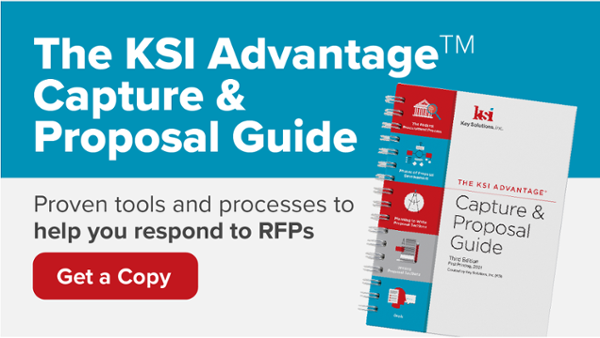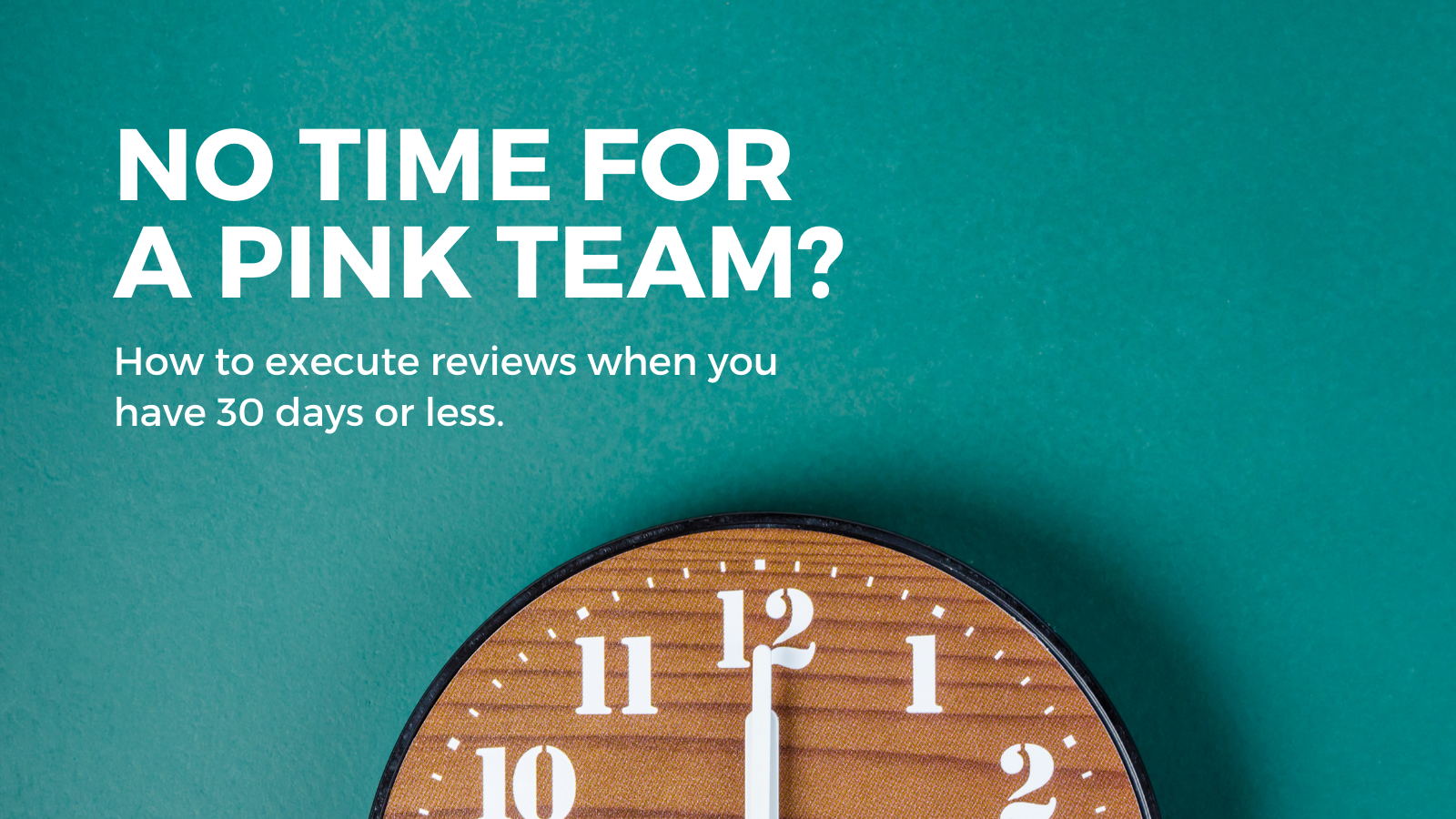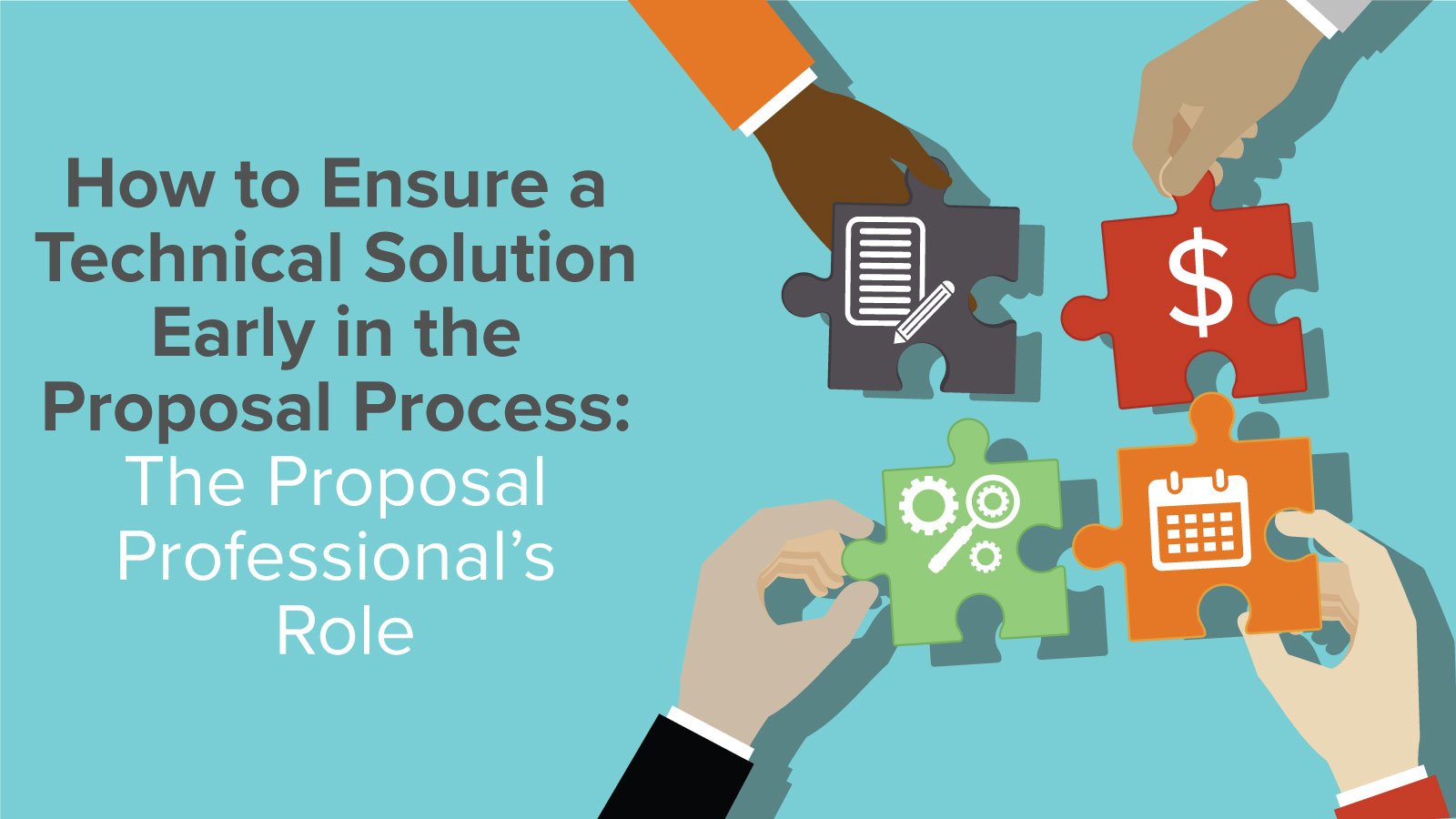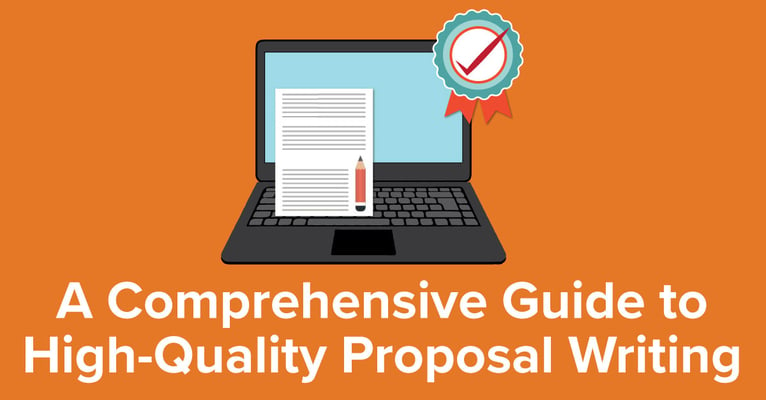
Writing is such a critical component of the proposal process. Because writing for proposals is different than most other writing, it is important to understand how to craft a proposal narrative that will resonate and score well with your evaluators.
If you are sloppy and careless in your proposal presentation, the customer can only assume that you will be similarly careless and sloppy in your contract delivery. That is why it is so important to take the time to develop well-written, well-structured proposal responses tailored to the customer and the evaluators.
This comprehensive guide will cover four key tactics to develop high-quality proposal content:
- Write to the evaluators and focus on the customer
- Apply proposal writing best practices
- Make strengths and benefits stand out visually
- Allow time for editing
1. Write to the Evaluators and Focus on the Customer
When writing proposals, teams tend to focus on their qualifications and their solution. They frequently take great care in telling the customer how great they are and describing the terrific solution they are delivering.
However, this is not a customer-focused approach. Instead, proposals should be about how the customer’s needs are met by your solution and the benefits the customer receives. Bottom line: the focus should be on the customer, not you.
Here are five tips to make your proposals more evaluator friendly and customer-focused:
- Use headings to guide evaluators
- Use the Request for Proposal (RFP) terminology and speak the customer’s language
- Put the customer first
- Use the customer’s name more than yours
- Write to the customer’s key issues/hot buttons and articulate the customer benefits.
Use Headings to Guide Evaluators.
When writing proposals, you need to present the information in a way that is easy for evaluators to score.
Understand that most evaluators do not volunteer for the job and do not particularly enjoy it. Proposal evaluations generally take time away from their regular job, so they want to get them over with as quickly as possible.
Therefore, you should aim to make the evaluator’s job as easy as possible. Compliance is the first thing evaluators will look for. To make compliance clear, structure your response headings according to the Proposal Instructions (typically Section L) and the Evaluation Criteria (typically Section M). Next map headings to other requirements, as required.
For example, in technical sections, it may be necessary to map to certain Statement of Work (SOW) areas (typically Section C). To facilitate the evaluation further, include relevant Request for Proposal (RFP) references in your section heading titles (e.g., 2.0 Staffing Approach [L.2, M.2, C.3.1]).
Use the RFP Terminology and Speak the Customer’s Language.
Another way to help evaluators is to use the language from the RFP. For example, if the RFP asks for a Program Manager, you should use the title, Program Manager, not Project Manager.
Additionally, your customer evaluators often do key word searches to find what is important to them in your proposal. Make sure all sections include key words from the instructions, evaluation criteria, and the Statement of Work (SOW).
In addition to using RFP terms and key words, you should use the customer’s terminology and lexicon in your proposal to gain their confidence. By knowing your customer and speaking their language, you demonstrate that you understand them, and you begin to establish trust.
Put the Customer First.
Remember, proposals should be about how the customer’s needs are met by your solution, not about how wonderful your company is and why the customer should choose you.
One of the easiest ways to make your proposal content more customer focused is to put them first—literally. Instead of saying, “Team ABC’s solution delivers a low-risk transition,” flip the construction and write, “Customer A receives a low-risk transition with our comprehensive transition approach.” The two sentences convey the same overall message, but by putting the customer first in the sentence, you shift the focus onto what the customer is receiving rather than what you are delivering.
Use the Customer’s Name More than Yours.
To determine whether your writing is more company-focused or customer focused, try this quick test.
Hit Ctrl-F and search for the number of times you mention your company and/or team name. Then search for the number of times you mention the customer’s name. You should aim to mention the customer’s name more time than yours. If you do not, go back and revise your text to focus more on the customer and the benefits they will receive by choosing your solution.
Write to the Customer’s Key Issues/Hot Buttons and Articulate the Customer Benefits.
Finally, to maintain a customer-focused response, you will want to write to the customer’s key issues and hot buttons and articulate the major customer benefits of your solution.
When documenting the major features and benefits to highlight in your proposal, start with the customer’s key issues and hot buttons. For each issue and hot button, identify solution features that address those major customer concerns. Next, articulate quantified benefits that the customer receives from the solution features. Benefits tell the customer why they should care about our solution or its features; they articulate the “so what?”
Benefits are almost always in terms of reduces cost, reduced risk, increased quality, increased efficiency, increased effectiveness, or expedited timeline. However, it is critical to remember that benefits should be things that the customer cares about. For example, if the customer does not care whether the transition is completed in five weeks or six weeks, then expedited timeline is not a benefit to that customer.
You should use these solution elements to generate hard-hitting section theme statements, proof points, and feature/benefit tables. But do not limit the articulation of benefits to these strategic proposal elements; remember to articulate customer benefits throughout the document narrative as well.
2. Follow Proposal Writing Best Practices
Poorly written proposals can obscure your message and make it difficult for the evaluator to follow your proposal’s logic and main points. Following proposal writing best practices can help you present your ideas clearly and comprehensively, in a way that can be easily understood and scored by the evaluators.
Key proposal writing best practices to follow include:
- Use active voice
- Substantiate claims and quantify where possible
- Use strong verbs
- Remove empty words and simplify your word choice
- Avoid incorrect words
- Split long sentences
- Make lists parallel
Use Active Voice.
A surefire way to strengthen your writing is to swap passive voice for active voice. Passive voice puts the subject and the action first, which can obscure who is performing the action. Passive voice also emphasizes the object of the sentence and can make your writing wordier and harder to follow. With active voice, the subject of the sentence comes first and performs the action in the sentence. Active voice is more straightforward and concise than passive voice. Active voice also typically results in shorter, sharper sentences. In addition, active voice also flows better and is easier to understand. See some examples in the table below.

Substantiate Claims and Quantify Where Possible.
Another way to strengthen your writing is to substantiate all claims, quantifying where possible. Unsubstantiated claims negate the credibility of the proposal response. Instead of using empty words such as high, numerous, and highly reliable, use quantified metrics instead (see examples in the table below). Adding specificity makes your proposal writing more credible and compelling. By adding proof statements as evidence and backing up our claims with facts and figures, you provide the necessary data for the evaluator to validate your solution.

Use Strong Verbs.
One of the easiest ways to strengthen your writing is to express actions in verbs. To do this, you will want to avoid using nominalizations. Nominalizations are actions expressed in nouns rather than verbs. Examples include failure, investigation, movement, reaction, and refusal. Replacing weak verbs and nominalizations with strong verbs will make your sentences more dynamic, direct, clear, and concise.

Strip out Empty Words and Simplify Your Word Choice.
Another way to strengthen your writing is to cut down on unnecessary wordiness. Concise writing makes your response clearer and easier to evaluate. Replace redundant phrases such as actual experience with experience; advanced planning with planning; close proximity with proximity; consensus of opinion with consensus. Remove clichés that do not add value, for example, world class, best of breed, and silver bullet. Avoid weak words, such attempt, believe, feel, intend, strive, and think. Additionally, writers sometimes feel the urge to add emphasis to their prose by using extra words or phrases that do not contribute to the meaning (and sometimes obscure it). Consider the swaps in the table below.
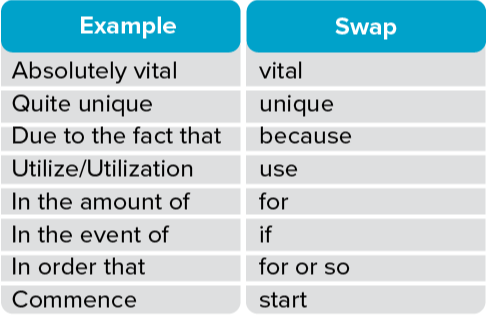
Visit https://plainlanguage.gov/guidelines/words/use-simple-words-phrases/ for a more comprehensive list.
Avoid Incorrect Words.
When you are typing fast and rushing, it is easy to use a homonym instead of the word that you really mean. Homonyms are words that that sound alike but have different meanings. Using the incorrect word can jar evaluators, discredit your response, and distract the evaluators from your intended message. Therefore, it is critical to go through your proposals and check for commonly misused words. Adding commonly misused words to your Wall of Truth and final editing checklist can help ensure you are the using the words you mean to use. See some examples of commonly confused words in the table below.
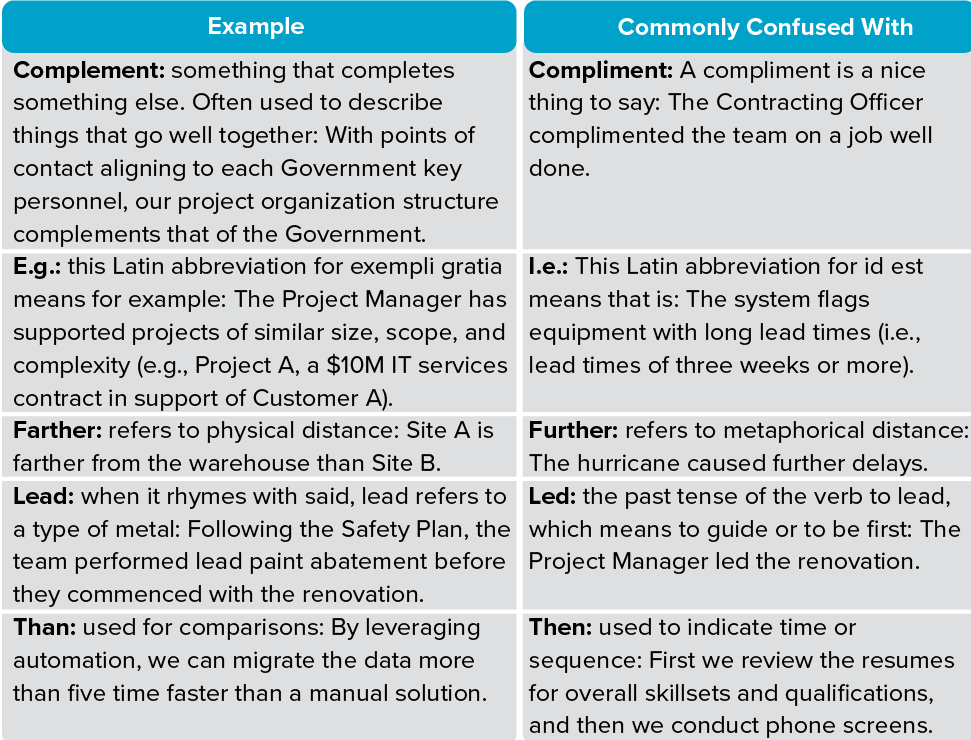
Split long sentences.
A fourth way to strengthen your proposal writing is to avoid cramming two or three main ideas into one long sentence. This can lead to long, drawn-out sentences and disjointed writing. It can also cause your message to lose focus. When you see a long, complex sentence in your section, first identify your main points. Then break the sentence into smaller sentences. To do this may require some rewording. See the example in the table below.

Make lists parallel.
A final way you can strengthen your writing is to make sure you are using parallel structure. Parallel structure is the repetition of a chosen grammatical form within a sentence or list. You should take care to ensure that each item in the list has the same structure.
To be parallel, each item in the list should start with the same part of speech, use the same verb tense, use the same voice, and use the same sentence/clause type. Parallel structure is easier for readers to process because they are primed for the pattern of the information. See the examples in the table below.
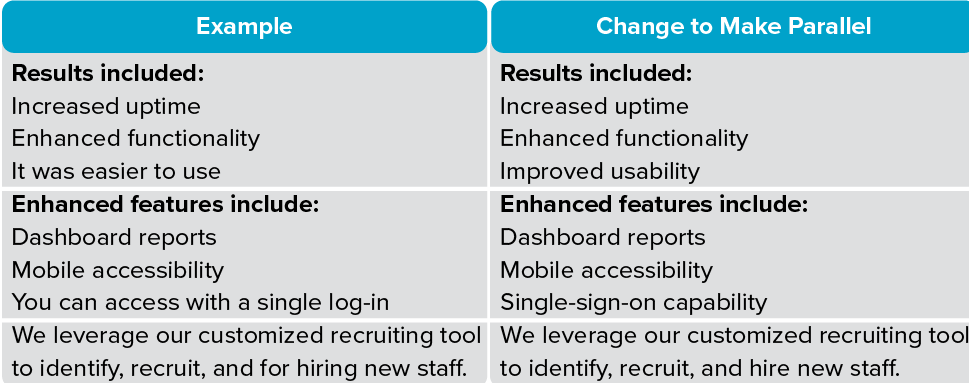
3. Make Strengths and Benefits Stand out Visually
Another way to strengthen your writing and make your narrative easier to score is to make strengths and benefits stand out visually. You can do this by using the tactics outlined below:
- Employ Theme Statements
- Leverage Feature and Benefit Tables
- Highlight Key Proof Points Using Callout Boxes
- Use Graphics and Tables
Employ Theme Statements.
Theme statements set the stage for the section and grab the evaluator’s attention because they address an issue that is important to the customer. The ideal theme statement not only presents a solution feature that addresses a customer hot button, it also articulates clear, quantified benefits. Include a theme statement for every first-level section and second-level subsection. For maximum effect, format your theme statements to stand out from the rest of the text. If you theme effectively, the theme statements will show up as identified strengths in the evaluation debrief from the customer.
Leverage Feature and Benefit Tables.
Feature and benefit tables are another great way to help evaluators find proposal strengths.
Similar to theme statements, feature and benefit tables highlight major solution features—that ideally address customer hot buttons—and articulate clear, quantified benefits. Typically, customers want things cheaper, faster, and/or better, which we might express as low cost, low risk, high quality, efficient, and/or effective.
Use feature and benefit tables in each major section introduction to highlight the key elements of your approach. This could be every first-level section for shorter proposals, but it may be useful to include them in second-level subsection for longer proposal responses.
Highlight Key Proof Points Using Callout Boxes.
Using callout boxes will help your major proof points stand out for the evaluators. To make proof points even more effective, make sure to provide the “so what?” statement in your callouts.
For example, it’s not enough simply to state: We have used our proven staffing process to staff programs with 3-, 7- and 14-day turnaround times, including the MNOP program, where we staffed 15 FTEs in two weeks. Ask yourself, “So what? What does this mean for my customer?” This might prompt you to add, Leveraging this staffing process, we provide Customer ABC with low-risk task order start-up and delivery for large, small, short-term, and long-term requirements.
Use Graphics and Tables.
You have probably heard the old adage, “A picture [or graphic] is worth a thousand words.”
If used correctly, graphics are compelling, easy to understand, informative, and help to communicate your message faster and more clearly than words alone.
Graphics can help evaluators to easily read data, understand processes, and identify patterns or potential opportunities. Remember to include a strong title and action caption for each graphic and table. The action caption should summarize the key takeaway from the graphic, including major features depicted and the resulting customer benefit or benefits—quantified if possible.
4. Allow Time for Editing
A narrative that is full of typos and grammatical errors will be perceived as less credible. That is why allowing time to edit your proposal text is so critical.
When editing your proposal sections, it can be helpful to use the following guidance:
- Check for subject/verb agreement, correct tenses, etc.
- Spell out and define acronyms on first use
- Check for correct capitalization, punctuation, and spelling
- Check for consistent formatting
- Check for correct word usage
- Check your response for consistency
Check for subject/verb agreement, correct tenses, etc.
When editing your proposal sections, you will want to be sure all sentences are complete. Look for subjects and verbs and make sure you are using active voice where practical.
Also, check that you are using correct tenses throughout. Completed tasks and past experience should generally be written in past tense. This is true in past performance volumes as well as in resumes. For technical and management approaches, the general proposal best practice is to use present tense rather than future tense (this makes the writing rhetorically stronger). However, even if you choose to use future tense, make sure you use the tense consistently throughout the narrative.
Spell out and define acronyms on first use.
To make things easier for the evaluator, define all the acronyms on first use. This will also help the person who ends up putting together your final acronym list!
Check for correct capitalization, punctuation, and spelling.
Most proposal style guides provide guidance on things like capitalization, bullet use, acronym use, and other common stylistic rules to follow. If you have time to clean your section up before it goes through the formal edit, you will help speed up the formal editing process.
Check for consistent formatting.
Make sure you are using the appropriate styles and formatting. Using the embedded styles within your Microsoft Word section template is a good first step! Following these conventions will also help speed up the desktop publishing and formal editing processes.
Check for correct word usage.
Change words that are not used correctly or that are unclear. Check for commonly misused words and other unclear formations in your draft. Check out this website for a great list! https://www.grammarly.com/blog/commonly-confused-words/
Check your response for consistency.
Verify that you reference terminology and key metrics consistently across your response, including: the customer, contract names, key proof points, tools, processes, etc. Consistency will also support the credibility of your response.
Conclusion
Poorly written proposals can obscure your message and make it difficult for evaluators to follow your proposal’s logic and main points.
If you are sloppy and careless in your proposal presentation, the customer can only assume that you will be similarly careless and sloppy in your contract delivery. Following these proposal best practices can help you to present your ideas clearly and comprehensively, in a way that can be easily understood and scored by the evaluators.
In addition to making your proposal easier to score, strong, high-quality writing can contribute to our company’s credibility in the eyes of the evaluator—which can certainly help improve your chances of winning overall!



